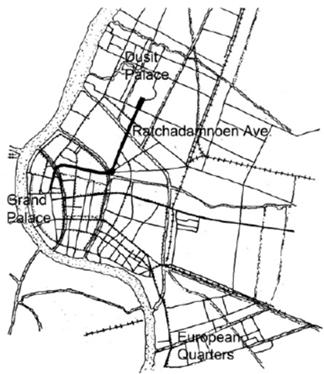
2 minute read
THE COMPROMISE BETWEEN TOP-DOWN AND BOTTOM-UP URBAN PLANNING
However, the arrival of overseas top-down urban models probably is the beginning of its failure. Winichakul (1994) claimed that the permanent transformation began from the contact with European colonial powers and their 'superior' land-biased culture and industrial technologies. Colonial administration practices were adopted, and centrally appointed nobles replaced hereditary lords in the hinterlands. King (2011) stated that the arrival of the railways and roads announced the new 'landbased' era in Thailand through the construction of the first road 'Charoen Krung' in 1862 based on the concept the European quarters which was a major commercial route into the following century. This urban morphological change instigated a schism with the water-based urban practices which transformed the 'Venice of the East' from a water-based into a land-based city. In 1887, the light rail service was introduced to the public, but it was only for upper classes. Land-based architectural typologies, such as the Chinese shophouses and European mansions on the ground began to replace the agricultural land and fishing villages (Jumsai, 1997, p. 170-171). The defensive wall and towers were demolished to expand north and east via boulevards and roads lined with neo-classical structures designed by European architects and engineers. The traditional canals were subordinated by these new urban developments facilitated by land-based transportation of road and railway (Fig. 4 and Fig. 5).
Fig. 4. Bangkok in the end century (source: author)
Advertisement

Fig. 5. Ratchadamnoen Avenue in Rama V's era (source: Foto_momo)
Moreover, Sintusingha and Mirgholami (2012) stated that the geopolitical power was changed after World War II, modernization's forms and practices were shifted from European to American. During this era, the development of Bangkok was dominated by an acceleration of market-driven urban expansion following top-down American urban models into the peripheral suburban which led to formation of specific urban morphologies in each city that connected modern highways with original rural forms and patterns especially the expansion of 'superblock', where is an urban area usually closed to through traffic, in Bangkok. After 1945, the reconstruction after World War II globally flourished driving urban growth, including Bangkok, highways and concrete buildings were built representing the modern format. During the first decade after the war, rural-urban migration drove the urban expansion of Bangkok, up to 50% of its population growth in 1960 and rose continuously until the 1970s (Archavanitkul, 1988, p. 8). Simultaneously, real-estate market in suburban area was established throughout the construction of new roads, displacing and turning prime agricultural lands and rural villages to be the city. The population in Bangkok and its suburbs grew dramatically from 400,000 people in the 19th century to six million in 1984 (Sintusingha and Mirgholami, 2012). Sintusingha and Mirgholami claimed that, by the late 2000s, Bangkok population grew over 10 million, the construction of the expressways and the first phases of the Skytrain and underground lines had been completed to serve the city's population. The metropolis was sprawling into suburbs, which concurrently produced high-rises, malls, factories, industrial estates, highways, and elevated expressways.




